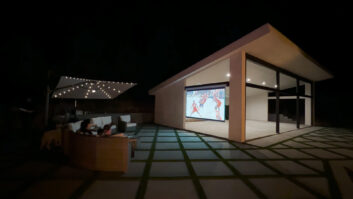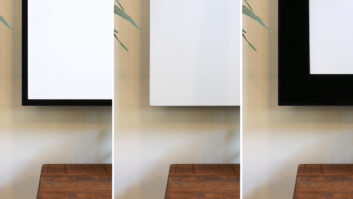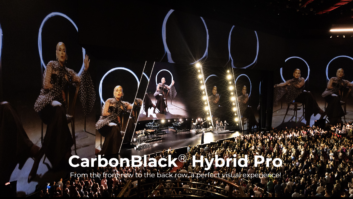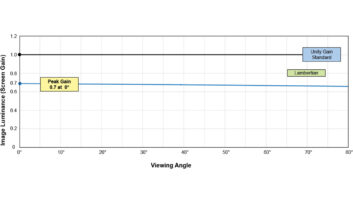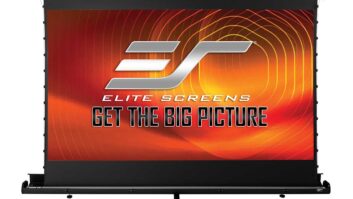In the past two months, a number of important events have taken place in the world of displaysincluding the science- and technology-driven annual convention of the Society of Information Display (SID) and its Display Week activities, the more business-oriented Projection Summit, as well as InfoComm, where the commercial, institutional, education, and digital signage worlds converge for their yearly conference. These events, along with the new models previewed during various consumer manufacturers line shows, paint a good picture of where display technology meets the products you can offer to your clients.
Look into the Light
One trend that is clearly evident is the emergence of alternate light sources. The objective is to replace the UHP bulbs found in front and rear projectors, and the CCFL bulbs found in direct view LCD displays, with something more energy efficient, less expensive, smaller and/or smaller in profile, that delivers better picture performance characteristics, such as contrast and color gamut. Unfortunately, there isnt anything out there that meets all of those requirements, but progress is being made.
Replacing the bulb in a front or rear projector has another important benefit: it eliminates the need to routinely replace bulbs for your clients. You will start to see the results of research in this direction this year with the introduction of DLP rear-screen projectors using LED or laser illumination. Samsung will lead the charge for the former, Mitsubishi will likely be first with the latter, while Sony is likely to join the fray toward the end of 2007, with a laser-illuminated version of its SXRD LCoS rear projector. Another bulb-less illumination technology comes from Luxim. Its microwave-excited technology is already available in rear-screen projectors from Panasonic under that companys LIFI brand.
The ability to have a light source with a reasonably unlimited life span, along with benefits such as virtually instant turn-on, are advantages of these technologies, though to date these features havent lowered product prices. However, what is gained is the ability to eliminate the color wheel when DLP is at work, and more important, the simplification of the optical path of laser and LCD displays so that deeper cabinets are possible. Remember, although LCD and plasma displays can be thin, unless they are mounted directly flat to the wall you need to consider the total footprint that includes the display as well as the articulated wall mount or the stand used when the display sits on a table or in cabinetry. The larger the screen size, the greater the footprintnot to mention the cost. However, with LED or laser optics, cabinets can be built to approach the grail of cabinet depth, about one-tenth the screen diagonal. At the moment, a seven-inch deep RPTV with a 70-inch screen size isnt here, but were getting close.
The bottom line is that as illumination technology in RPTV moves away from bulbs, cabinets for large-size displays will, at the least, approach the total footprint of LCD or PDP. Add the fact that LED-based RPTVs above 60 inches will be priced at a third to a quarter of comparably sized flat-panel displays, and you quickly gain more respect for the rear-projection category than it has received in recent years.
LED Possibilities
While LED-based projectors for both front- and rear-projection applications are in the pipeline, the use of LEDs to replace CCFL bulbs in direct-view LCD displays was a visible trend at Display Week. At this time it is a premium-priced product technology with a greater life span than CCFL systems, but LED systems also eliminate the materials inside the tubes that pose a threat as we move toward a greener world. Even better, depending on their configuration, they may be used as edge lighting to reduce the depth of the total LED panel system, or as a more traditional full backlight that, unlike bulbs, may easily be modulated in sync with the image to turn off illumination to discrete areas of the panel, or for a specific color so that contrast is greatly improved. Demonstrations of this at SID were very convincing, and make LED backlighting a technology to look for as it makes its way to the market.
OLED Offerings
Another long-standing goal in the display technology world is to bring technologies to the market thatunlike LCD direct view or LCD, DLP, or LCoS rear projectorsare emissive. The Canon/Toshiba SED technology was to be one such product, but it was nowhere to be seen at any of late springs display trade shows or conferences. A combination of legal issues as well as reports of problems in taking SED from the prototype stage to mass production seem to have doomed it. There is the chance it may appear in a year or two, but the window of opportunity for SED may be closing fast.
Not so for flat panel technologies that, unlike CRT and PDP, avoid the use of phosphorswith their susceptibility to image retention (burn-in) depletion over time, and environmental unfriendliness. The most noise about new, non-phosphor-based flat-panel alternatives is in the world of OLED. This technology has been available in small sizes for some time, but there is the feeling that after years of being pigeonholed into the small-size market or classified as just not practical for larger displays, OLED is on the way.
You may have got a hint of OLEDs future at CES, where Sony showed 11-inch-wide OLED sets and promised their delivery this year, along with a prototype of a 27-inch-wide model that has no stated production date set. OLEDs were everywhere at SID, both as actual products or prototypes, and perhaps more importantly, as machinery and materials used to manufacture them. Others such as Samsung demonstrated OLED displays, while other companies like Toshiba and their joint TMD venture with Matsushita are on track to deliver sizes up to, and possibly larger than, 30 inches before the end of the decade.
Yes, we have seen other potentially disruptive display technologies such as GLV, iFire, and SED receive a great deal of publicity only to retreat to the labs, or perhaps disappear altogether. Will OLED make it where others have not? For small-size (under five inches) displays, OLED is definitely a player. In more theater-friendly sizes it remains to be seen if OLED can succeed where other technologies have failed, but at this point the odds seem favorable despite what will inevitably be premium pricing in early stage products. As your more tech-savvy clients read about OLED in the enthusiast or financial press, as well as in the general media, remind them that it is still a bit off in the distance, and issues such as product life and cost will need to be weighed against the benefits of increased contrast and response time.
Micro-Projectors
Also a bit off in the future is a new product category: micro-projectors. With the design goal to fit a projector inside a cell phone (or at the most in a form factor that is about the size of a paperback book), these projectors wont replace the beasties in the home theater, but they could lead to a range of applications from mood video to replacements for digital picture frames. Products shown in prototype from Explay, under its oio branding, and PicoP from aptly named Microvision, have the potential to completely change the notion of what you can do with video projection and where you can use or install it. Picture a WVGA image in full color and at menu size from a unit only 7-mm thick and you get the idea of what scientists are working toward in this category. Again, this is still at least 12 to 24 months away at the earliest, but if someone asks you about what is out there just over the horizon, micro-projectors are something to talk about.
Where does all of this prognostication meet reality? Tune in next month as we expand the broader view of what the leading brands will be offering this fall and into next year, based on our annual review of the vendor line shows.
Michael Heiss ([email protected]) is an industry consultant in Los Angeles, California.

